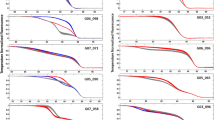Abstract
The female gametophyte is an absolutely essential structure for angiosperm reproduction, and female sterility has been reported in a number of crops. In this paper, a maximum-likelihood method is presented for estimating the position and effect of a female partial-sterile locus in a backcross population using the observed data of dominant or codominant markers. The ML solutions are obtained via Bailey’s method. The process for the estimating of the recombination fractions and the viabilities of female gametes are described, and the variances of the estimates of the parameters are also presented. Application of the method is demonstrated using a set of simulated data. This method circumvents the problems of the traditional mapping methods for female sterile genes which were based on data from seed set or embryo-sac morphology and anatomy.




Similar content being viewed by others
References
Arthur L, Ozias-Akins P, Hanna WW (1993) Female sterile mutant in pearl millet: evidence for initiation of apospory. J Hered 84:112–115
Bailey NTJ (1951) Testing the solubility of maximum likelihood equations in the routine application of scoring methods. Biometrics 7:268–274
Bingham ET, Hawkins-pfeiffer J (1984) Female sterility in alfalfa due to a recessive trait retarding integument development. J Hered 75:231–233
Brandt S (1983) Statistical and computational methods in data analysis. Elsevier/North-Holland Inc., New York
Casady AJ, Heyne EG, Weibel DE (1960) Inheritance of female sterility in sorghum. J Hered 51:35–38
Daskalov S, Mihailov L (1988) A new method for hybrid seed production based on cytoplasmic male sterility combined with a lethal gene and a female sterile pollenizer in Capsicum annuum L. Theor Appl Genet 76:530–532
Dhesi JS (1966) An embryological study of female sterility in cotton. J Hered 57:247–248
Drews GN, Lee D, Christensen CA (1998) Genetic analysis of female gametophyte development and function. Plant Cell 10:5–18
Dudoit S, van der Laan MJ (2008) Multiple testing procedures with applications to genomics. Springer, New York
Ficcadenti N, Sestili S, Pandolfini T, Cirillo C, Rotino GL, Spena A (1999) Genetic engineering of parthenocarpic fruit development in tomato. Molecular Breeding 5:463–470
Goldman MH, Goldberg RB, Mariani C (1994) Female sterile tobacco plants are produced by stigma-specific cell ablation. EMBO J 13:2976–2984
Hanna WW, Powell JB (1974) Radiation-induced female-sterile mutant in pearl millet. J Hered 65:247–249
Honma S, Phatak SC (1964) A female-sterile mutant in the tomato. J Hered 55:143–145
Kato KK, Palmer RG (2003a) Genetic identification of a female partial-sterile mutant in soybean. Genome 46:128–134
Kato KK, Palmer RG (2003b) Molecular mapping of the male-sterile, female-sterile mutant gene (st8) in soybean. J Hered 94:425–428
Klucher KM, Chow H, Reiser L, Fischer RL (1996) The AINTEGUMENTA Gene of Arabidopsis required for ovule and female gametophyte development is related to the floral homeotic gene APETALA2. Plant Cell 8:137–153
Kubo T, Yoshimura A (2005) Epistasis underlying female sterility detected in hybrid breakdown in a Japonica–Indica cross of rice (Oryza sativa L.). Theor Appl Genet 110:346–355
Li S-C, Yang L, Deng Q-M, Wang S-Q, Wu F-Q, Li P (2006) Phenotypic characterization of a female sterile mutant in rice. J Integr Plant Biol 48:307–314
Liu YS, Zhu LH, Sun JS, Chen Y (2001) Mapping QTLs for defective female gametophyte development in an inter-subspecific cross in Oryza sativa L. Theor Appl Genet 102:1243–1251
Luo L, Xu S (2003) Mapping viability loci using molecular markers. Heredity 90:459–467
Luo L, Zhang YM, Xu S (2005) A quantitative genetics model for viability selection. Heredity 94:347–355
Moore JM, Calzada JP, Gagliano W, Grossniklaus U (1997) Genetic characterization of hadad, a mutant disrupting female gametogenesis in Arabidopsis thaliana. Cold Spring Harb Symp Quant Biol 62:35–47
Pereira TNS, Lersten NR, Palmer RG (1997) Genetic and cytological analyses of a partial-female-sterile mutant (PS-1) in soybean (Glycine max; Leguminosae). Am J Botany 84:781–791
Robinson-Beers K, Pruitt RE, Gasser CS (1992) Ovule development in wild-type Arabidopsis and two female-sterile mutants. Plant Cell 4:1237–1249
Rosellini D, Lorenzetti F, Bingham ET (1998) Quantitative ovule sterility in Medicago sativa. Theor Appl Genet 97:1289–1295
Stroman GN (1941) A heritable female-sterile type in cotton. J Hered 32:167–168
Vogl C, Xu S (2000) Multipoint mapping of segregation distorting loci using molecular markers. Genetics 155:1439–1447
Wan H, Mann TJ (1967) Inheritance of a female sterility in tobacco. J Hered 58:85–87
Wang C, Zhu C, Zhai H, Wan J (2005) Mapping segregation distortion loci and quantitative trait loci for spikelet sterility in rice (Oryza sativa L.). Genet Res 86:97–106
Weir BS (1990) Genetic data analysis-methods for discrete population genetic data. Sinauer Associates Inc, Sunderland
Author information
Authors and Affiliations
Corresponding author
Additional information
Communicated by M. Sillanpaa.
Appendix
Appendix
Derivation of the formula:
Rights and permissions
About this article
Cite this article
Chen, J., Walsh, B. Method for the mapping of a female partial-sterile locus on a molecular marker linkage map. Theor Appl Genet 119, 1085–1091 (2009). https://doi.org/10.1007/s00122-009-1110-6
Received:
Accepted:
Published:
Issue Date:
DOI: https://doi.org/10.1007/s00122-009-1110-6




